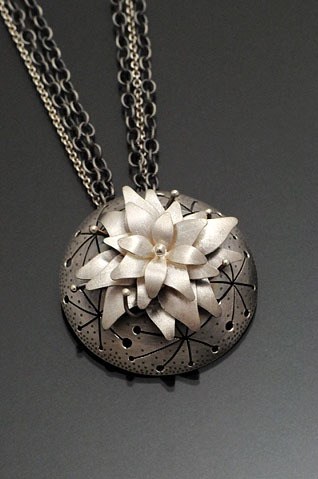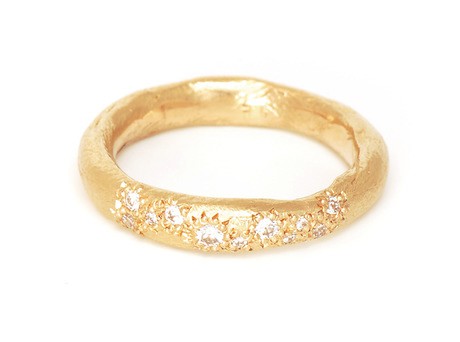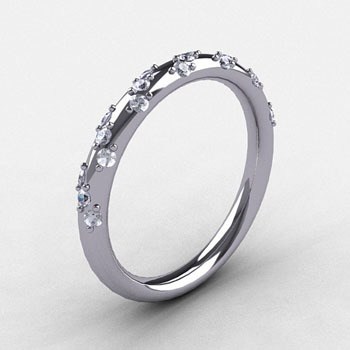This post has been prompted by something I’ve seen several times recently that makes my toes curl and my ears cringe – the wrong metal in the wrong place. Yep, it’s one of my pet hates. I’ll tell you more about why later.
While you CAN make jewellery out of just about anything (I urge you to check out the paper jewellery of uber-crafter Nel Linssen if you have a moment, and also the plastic flowers of Melinda Young), the most common preference is for jewellery that is made out of metal. And why not? It’s durable, with lots of relatively easy ways to shape it, and it holds its finished shape well. Lots of people like it because many types can be polished to a high shine as well (ooooh, shiny!).
However, there are a huge number of metals out there. Quite apart from pure metals as found on the Periodic Table, there are countless alloys, each having its own particular qualities. Because each material has its own particular qualities, this means that one material is not suitable for everything.
More importantly however, it means that some materials are definitely NOT suitable for some things.
I’ll go through a few of the more common metals and alloys and their relative usefulness in making jewellery. And being a trained jeweller and silversmith myself, I found that in writing this post it was incredibly hard to keep it short, because there’s SO much to know!! And I’ve hardly scratched the surface. Hence this post will be in two parts – precious and non-precious metals. Here goes.
Gold: I think it’s the very prettiest of metals, with rich colour and a beautiful lustre. It’s lovely to work with! It is very malleable (pliable) and ductile (capable of being drawn into wire), and 30 grams of gold can be flattened to a sheet that would cover almost 10 square metres, or made into a wire that can be drawn out to 1.7 kms.
- Pure gold is too soft for most uses. It’s usually alloyed with other metals to make it harder – commonly with silver, copper, and/or nickel. Different alloys will alter the colour, and the melting point – rose gold has gold mixed with copper to give it a pinkish colour, and a 50/50 mix of gold and silver will make a special alloy called electrum, which is a lustrous pale yellow.
- The karat refers to the purity of gold, with 24k being pure, and 18k being 75% gold. High karat gold is lovely to work with, but is unfortunately out of financial reach for many of us.
- The purer the gold, the less likely it is to cause skin irritations in those with sensitive skin.
- Take extra care with alloys containing nickel, as nickel can be a problem for people with sensitive skin.
- Gold-filled is not pure gold! Sometimes called rolled gold, it refers to an item made from a base metal such as nickel or copper, which is then thickly plated in a medium-karat gold. The standard varies a little around the world, but in Australia, the plating is usually 14k gold, and the gold content makes up 5% of the item’s total weight.
- Vermeil refers to sterling silver plated with 24k gold, and is good for those with sensitive skin.
- Low karat gold (e.g. 9k, which is 37.5% gold), depending on its alloy, can be difficult and brittle to work with, and is much more likely to cause skin irritations. I wouldn’t recommend it.

sooyoung kim – pendant – 925, constructed, saw pierced, & oxidised
Silver: At one time {so the story goes} silver was held to be more precious than gold because it appeared less commonly in nature. It is lustrous and white, and has been associated with the moon in many cultures. It’s by far the most used material in my own jewellery work.
- It is the most common precious metal used in jewellery, primarily because its relative cheapness (currently close to 1/50th of the price of gold), attractive appearance and excellent working properties.
- Pure silver is harder than pure gold, but it is still a bit soft for making rings, earwires and brooch pins, where the metal gets a bit of wear and tear.
- For this reason, it is alloyed – 92.5% silver with 17.5% copper to make it harder, and it is called sterling silver or 925.
- Sterling is relatively easily to shape and solder, although when it is subjected to prolonged heating, it can get firescale – this is where the copper in it oxidises on the surface, leaving an ugly purplish stain. Prevention is better than cure, and it can be avoided by using plenty of flux, and soldering quickly. It can be removed by filing it off and repolishing your item, or by heating it and dipping it direct into pickle (dilute sulphuric acid), repeating several times – but SAFETY, PLEASE!
Platinum: One of the rarest elements in the earth’s crust (much rarer than gold), platinum is also one of the heaviest. Several of the world’s most famous diamonds, including the Hope and the Koh-I-Noor are set in platinum. I’ve not had the honour of working with it, but would love to hear from you if you have!
- It is light grey in colour, and is capable of a very high polish.
- It is roughly the same price as gold, although it is subject to quite large fluctuations in price as its rarity makes it a sensitive commodity.
- It is more ductile than gold, although slightly less malleable.
- It is extremely resistant to wear and corrosion, hence it is highly suitable for jewellery.
- It is also hypo-allergenic, making it perfect for those with sensitive skin.
If you are serious about making quality jewellery, you need to understand your materials properly, and you need to do some of your own research. There is oodles of information out there! Go to the library and find a few good books – you need the materials and tools knowledge before you start.
The very best, fastest way of learning is a hands-on class with an experienced teacher.
I cannot emphasise this enough. If it is not possible to get to a classroom, the next best thing is just get yourself set up at home and have a go. Learn by doing. Understanding the theory is not the same as understanding the practice – you need to feel those materials in your hands, and see what they do with your own eyes. Now go to it!
*
Stay tuned for the next part of this post – “How-to : Choosing your materials for jewellery – Part (ii) – non-precious metals”. And I might even follow it up with a post on my favourite basic tools to set up a workbench with – what do you think?
Seeya, Julie x



Yay! can’t wait to see you making some stuff! Huzzah!
Right up my alley at the moment! I just posted about my tool collection. I’d love to hear your suggestions too!
I don’t really have anything useful to add to your article because it is not really my forte. Just wanted to say thank you for such an informative article!
I love seeing people work with unexpected materials, especially when they combine them with precious metals. I totally agree, the right material for the job is a must!! 9K ‘gold’, rolled ‘gold’ and nickel ‘silver’ all make me cry a little bit inside… although I’m sure they’re good for something 🙂
Exactly right Ruthie – and the ability to use unusual materials well comes from understanding exactly what they are and how they behave!
As for those other things you mention, it’s not about how precious/not precious they are, it’s about how well they do their designated job. It’s my personal mission to rid the world of poorly made things 😉
Sending you a virtual hug for clearing up the path Julie!!!
Wrong metal in the wrong place, wrong solder in the wrong place, wrong tools for the job, wrong gemstone… The list is sadly very long!
One thing I would add is alloys with nickel are handy for some things like springs in clasps BUT can give allergies to people like me.
Can’t wait for part 2 🙂
Thanks Annaig! I’ve written about nickel and nickel alloys in Part ii, but I will amend this section to include a little info. Cheers 🙂